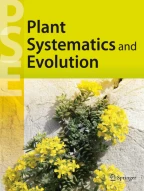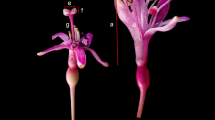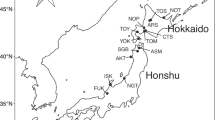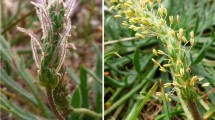Abstract
The occurrence of gynodioecy in two populations in northern England of the normally hermaphroditeSaxifraga granulata is reported. Female plants have aborted stamens, and smaller petals than hermaphrodites. At Staindrop, County Durham, an estimated 23% of the flowering stems were female; at Macclesfield, Cheshire, 4% were female. The inheritance of male sterility is not simple, and probably involves at least one cytoplasmic and two nuclear genes. The secondary sexual characteristics, hermaphrodite-predominant sex ratios, and complex inheritance of male sterility, are typical of gynodioecious populations.
Article PDF
Similar content being viewed by others
Avoid common mistakes on your manuscript.
References
Baker, H. G., 1948: Corolla-size in gynodioecious and gynomonoecious species of flowering plants. — Proc. Leeds Phil. Lit. Soc.5, 136–139.
Charlesworth, B., Charlesworth, D., 1978: A model for the evolution of dioecy and gynodioecy. — Am. Nat.112, 975–997.
Charlesworth, D., 1981: A further study of the problem of the maintenance of females in gynodioecious species. — Heredity46, 27–39.
Cosmides, L. M., Tooby, J., 1981: Cytoplasmic inheritance and intragenomic conflict. — J. Theor. Biol.89, 83–129.
Darwin, C., 1877: The Different Forms of Flowers on Plants of the Same Species. — London: Murray.
Dommée, B., Assouad, M. W., Valdeyron, G., 1978: Natural selection and gynodioecy inThymus vulgaris L. — Bot. J. Linn. Soc.77, 17–28.
Dulberger, R., Horovitz, A., 1984: Gender polymorphism in flowers ofSilene vulgaris (Moench)Garcke (Caryophyllaceae). — Bot. J. Linn. Soc.89, 101–117.
Edwardson, J. R., 1970: Cytoplasmic male sterility. — Bot. Rev.36, 341–420.
Eberhard, W. G., 1980: Evolutionary consequences of intracellular organelle competition. — Q. Rev. Biol.55, 231–249.
Horovitz, A., Dulberger, R., 1983: The genetic basis of gender inSilene vulgaris. — Heredity51, 371–376.
Kheyr-Pour, A., 1980: Nucleo-cytoplasmic polymorphism for male sterility inOriganum vulgare L. — J. Hered.71, 253–260.
—— 1981: Wide nucleo-cytoplasmic polymorphism for male sterility inOriganum vulgare L. — J. Hered.72, 45–51.
Lloyd, D. G., 1974a: Theoretical sex ratios of dioecious and gynodioecious angiosperms. — Heredity32, 11–34.
—— 1974b: The genetic contributions of individual males and females in dioecious and gynodioecious angiosperms. — Heredity32, 45–51.
—— 1975: The maintenance of gynodioecy and androdioecy in angiosperms. — Genetica45, 325–339.
—— 1976: The transmission of genes via pollen and ovules in gynodioecious angiosperms. — Theor. Pop. Biol.9, 299–316.
Löve, A., Löve, D., 1951: Studies on the origin of the Icelandic flora. II.Saxifragaceae. — Svensk Bot. Tidskr.45, 368–399.
Marsden-Jones, E. M., Turrill, W. B., 1947: A quantitative study of petal size and shape inSaxifraga granulata L. — J. Genet.48, 206–218.
Müller, H., 1883: The Fertilisation of Flowers. (Translated and edited byThompson, D. W.) — London: Macmillan.
Plack, A., 1957: Sexual dimorphism inLabiatae. — Nature180, 1218–1219.
—— 1958: Effect of gibberellic acid on corolla size. — Nature182, 610.
Ross, M. D., 1978: The evolution of gynodioecy and subdioecy. — Evolution32, 174–188.
—— 1982: Five evolutionary pathways to subdioecy. — Am. Nat.119, 297–318.
Schultz, A., 1890: Beiträge zur Kenntnis der Bestäubungseinrichtungen und Geschlechtsvertheilung bei den Pflanzen. II. — Bibl. Bot.3, 1–224.
Stevens, D. P., 1985 (in preparation): Studies on variation and reproductive biology inSaxifraga granulata L. — Ph.D. Thesis, University of Newcastle upon Tyne.
Van Damme, J. M. M., 1983: Gynodioecy inPlantago lanceolata L. II. Inheritance of three male sterility types. — Heredity50, 253–273.
Van Damme, J. M. M., Van Delden, W., 1982: Gynodioecy inPlantago lanceolata L. I. Polymorphism for plasmon type. — Heredity49, 303–318.
Winer, B. J., 1971: Statistical Principles in Experimental Design. Second edition. — Tokyo: McGraw-Hill Kogakusha.
Author information
Authors and Affiliations
Rights and permissions
About this article
Cite this article
Stevens, D.P., Richards, A.J. Gynodioecy inSaxifraga granulata L. (Saxifragaceae). Pl Syst Evol 151, 43–54 (1985). https://doi.org/10.1007/BF02418018
Received:
Issue date:
DOI: https://doi.org/10.1007/BF02418018




